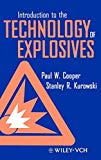 Plastic explosives are soft explosives which can be molded into convenient shapes.
Plastic explosives are soft explosives which can be molded into convenient shapes.
Plastic explosives tend to be safe from accidental detonation caused by fire and impact.
The convenience and safety of plastic explosives makes them very well suited for military application. The higher relative costs of plastic explosives means that they are not commonly utilized for commercial blasting.
Common plastic explosives include:
- C-4 (RDX with with polyisobutylene and di(2-ethylhexyl)sebacate)
- PENO
- Primasheet
- RDX
- Semtex (RDX with PETN)
Reading Material on Plastic Explosives
C-4
An RDX-based plastic explosive
Semtex
A plastic explosive based on both RDX and PETN
RDX
A plastic explosive and ingredient in other plastic explosives
On predicting the effective elastic properties of polymer bonded explosives using the recursive cell method
Polymer bonded explosives are particulate composites containing elastic particles in a viscoelastic binder. The particles occupy an extremely high fraction of the volume, often greater than 90%. Under low strain rate loading (~0.00a-1 s-1) and at room temperature and higher, the elastic modulus of the particles can be four orders of magnitude higher than that of the binder. Rigorous bounds and analytical estimates for the effective elastic properties of these materials have been found to be inaccurate. The computational expense of detailed numerical simulations for the determination of effective properties of these composites has led to the search for a faster technique. In this work, one such technique based on a real-space renormalization group approach is explored as an alternative to direct numerical simulations in determining the effective elastic properties of PBX 9501. The method is named the recursive cell method (RCM). The differential effective medium approximation, the finite element method, and the generalized method of cells (GMC) are investigated with regard to their suitability as homogenizers in the RCM. Results show that the RCM overestimates the effective properties of particulate composites and PBX 9501 unless large blocks of subcells are renormalized and the particles in a representative volume element are randomly distributed. The GMC homogenizer is found to provide better estimates of effective elastic properties than the finite element based homogenizer for composites with particle volume fractions less than 0.80.
Taggants in Explosives
Tagging of explosives can refer to two types of marking technologies. Detection taggants are used to enhance the detection of explosives before detonation. Identification taggants are intended to be used to trace explosive materials to their source after detonation. The Antiterrorism Act of 1996 requires a detection taggant, or agent, be added to plastic explosives. Without such an additive, plastic explosives can be difficult to detect, and could pose a security threat in the hands of terrorists. These detection agents can be added to plastic and sheet explosive products to make them more “visible” to existing detection equipment without compromising safety or the performance of affected materials. IME has continually supported the development of such detection technologies. However, identification taggants present a different story.
Questionable Reading Materials on Explosives — Don’t Trust This Stuff
Platic Explosive from Aspirin
This explosive is a phenol dirivative. It is toxic and explosive compounds made from picric acid are poisonous if inhaled, ingested, or handled and absorbed through the skin.
Plastic Explosive from Bleach
This explosive is a potassium chlorate explosive.
Plastic Explosives from Swimming Pool Chlorinating Compound
This explosive is a chlorate explosive from bleach. This method of production of potassium or sodium chlorate is easier and yields a more pure product than does the plastique explosive from bleach process.
Gelatin Explosive from Anti-Freeze
This explosive is almost the same as the nitro-gelatin plastique explosive exept that it is supple and pliable to -10 to -20 deg. C.
Books on Plastic Explosives

Introduction to the Technology of Explosives
Introduction to the Technology of Explosives Paul W. Cooper and Stanley R. Kurowski Introduction to the Technology of Explosives is a clear and concise survey of the technologies and physical processes involved in explosive phenomena. The book is intended to provide the worker new to the field with sufficient background to understand problems that may arise and to interact intelligently with specialists in the field. The book covers the fundamentals of the chemistry of explosives; the mechanics of burning; sound, shock, and detonation; initiation and initiators; scaling in design and analysis; and off-the-shelf explosive devices. It provides the basic calculational skills needed to solve simple, first-order engineering design problems, and emphasizes the crucial importance of safety considerations. The book contains a broad range of data on explosive materials, and their properties and behavior, along with extensive lists of useful references. Example problems with solutions are provided in each technical area, as are descriptions and analysis of a wide variety of explosive devices. The book concludes with a thorough and comprehensive description of regulatory requirements for the classification, transportation, and storage of explosives, and an extensive guide to explosives safety in plant and test facilities. This book will be of interest to explosives technicians and engineers, government regulators, crime and accident scene investigators, and instructors in military, police, and FBI bomb schools.

Home Workshop Explosives, Second Edition
This book earns the title! Over the course of 172 pages, I have taken all of the great material in the first edition and added to it a series of recipes and procedures which produce military grade explosives from commonplace items and materials. In doing so, I conclusively prove that the restrictions which have been placed upon the access to the commercially produced explosives which were so freely available in my youth are all futile. The real enemies in “the war on terror” are not inanimate objects such as explosives. The real enemies are the politicians who have flung open our borders to infiltration by Moslem guerrillas. These guerrillas are already well versed in the techniques of improvised weaponry manufacture.
This treasure trove of explosive information features The Hardware Store Nitro Recipe, Fuel/Air Explosives, military equivalent ammonium nitrate formulations, nitromethane mixtures, and a vastly improved detonator section.
The expose`of the folly of our present policies doesn’t stop there either! Read all about the construction of remote control cruise missiles and RC torpedoes. Claymore mines and air cannons add spice to the stew. Then top it all off with my commentary on the easiest ways to obtain all the materials mentioned in the book.
I’ve read all the books on the topic of explosives from tiny paperbacks to 600 page texts written by PhDs. I have no hesitation saying this book tops them all! It’s my hope that when you finish reading this book, politicians will no longer be able to fool or distract you by blaming an inanimate object such as explosives for the direct results of their disastrous policies.

Homemade C-4 A Recipe For Survival: A Recipe For Survival
Survivors know that the day may come when they need something more potent than dynamite. For blowing up bridges, shattering steel and derailing tanks, they need C-4. But it is not available in the U.S., so find out how to make your own by following Ragnar’s step-by-step instructions. For information purposes only.

Homemade Semtex: C-4’s Ugly Sister
This first book focusing on Semtex, the plastique most widely used by terrorists around the world, sets the record straight about this powerful but misunderstood explosive. Find out what it will and won’t do, its strengths and weaknesses, and how it compares to its U.S. counterpart, C-4.
Videos on Plastic Explosives

High Explosives
When people think of war, guns, tanks, planes and rockets spring to mind. But without high explosives, none of these weapons would work. More than anything else, gunpowder and its many other combustible cousins are at the heart of modern warfare. HIGH EXPLOSIVES ventures from Ancient China to today’s high-tech battlefields to tell the story of the powders, plastics and countless other explosive mixes mankind has developed in the unending quest to create the perfect weapon. Find out about the many different types of explosives, from mines to ballistic missile payloads, and see how they were developed and deployed. See stunning evidence of their incredible power in the lab and on the battlefield and learn what the future of explosives may hold. And join military historians as they trace the refinement of battlefield explosives, and how they have changed the face of warfare.
